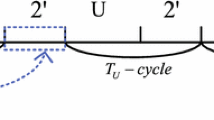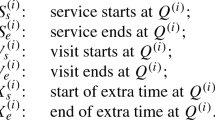Abstract
We consider a system of two separate finite-buffer M / M / 1 queues served by a single server, where the switching mechanism between the queues is threshold-based, determined by the queue which is not being served. Applications may be found in data centers, smart traffic-light control and human behavior. Specifically, whenever the server attends queue i (\(Q_i\)) and the number of customers in the other queue, \(Q_j\) (\(i,j=1,2\); \(j\ne i\)), reaches its threshold level, the server immediately switches to \(Q_j\) whenever \(Q_i\) is below its threshold. When a served \(Q_i\) becomes empty we consider two scenarios: (i) non-work-conserving; and (ii) work-conserving. We present occasions where the non-work-conserving policy is more economical than the work-conserving policy when high switching costs are involved. An intrinsic feature of the process is an oscillation phenomenon: when the occupancy of \(Q_i\) decreases the occupancy of the other queue increases. This fact is illustrated and discussed. By formulating the system as a three-dimensional continuous-time Markov chain we provide a probabilistic analysis of the system and investigate the effects of buffer sizes and arrival rates, as well as service rates, on the system’s performance. Numerical examples are presented and extreme cases are investigated.








Similar content being viewed by others
References
Arazi A, Ben-Jacob E, Yechiali U (2005) Controlling an oscillating Jackson-type network having state-dependant service rates. Math Methods Oper Res 62:453–466
Avram F, Gómez-Corral A (2006) On the optimal control of a two-queue polling model. Oper Res Lett 34:339–348
Boon MAA, van der Mei RD, Winands EMM (2011) Applications of polling systems. Surv Oper Res Manag Sci 16(2):67–82
Boxma OJ, Down DG (1997) Dynamic server assignment in a two-queue model. Eur J Oper Res 103:595–609
Boxma OJ, Koole GM, Mitrani I (1995a) A two-queue polling model with a threshold service policy. In: Dowd PW, Gelenbe E (eds) Proceedings MASCOTS ’95. IEEE Computer Society Press, Los Alamitos, pp 84–89
Boxma OJ, Koole GM, Mitrani I (1995b) Polling models with threshold switching. In: Baccelli F, Jean-Marie A, Mitrani I (eds) Quantitative methods in parallel systems. Springer Verlag, Berlin, pp 129–140
Bright LW, Taylor PG (1995) Calculating the equilibrium distribution in level dependent quasi-birth-and-death processes. Stoch Models 11(3):497–526
Coffman EG Jr, Puhalskii AA, Reiman MI (1995) Polling systems with zero switchover times: a heavy-traffic averaging principle. Ann Appl Probab 5(3):681–719
Da Fonseca CM (2006) On the location of the eigenvalues of Jacobi matrices. Appl Math Lett 19(11):1168–1174
De Nitto Personè V, Grassi V (1996) Solution of finite QBD processes. J Appl Probab 33(4):1003–1010
Haverkort B, Idzenga HP, Kim BG (1994) Performance evaluation of threshold-based ATM cell scheduling policies under Markov modulated Poisson traffic using stochastic Petri nets. In: Modelling and evaluation of ATM networks, vol 17, IFIP Conference Proceedings. Chapman & Hall, pp 553–572
Latouche G, Ramaswami V (1999) Introduction to matrix analytic methods in stochastic modeling. SIAM and ASA, Philadelphia
Lee D-S (1996) A two-queue model with exhaustive and limited service disciplines. Commun Stat Stoch Models 12(2):285–305
Lee D-S, Sengupta B (1993) Queueing analysis of a threshold based priority scheme for ATM networks. IEEE/ACM Trans Netw 1(6):709–717
Litvak N, Yechiali U (2003) Routing in queues with delayed information. Queueing Syst 43:147–165
Neuts MF (1981) Matrix geometric solutions in stochastic models—an algorithmic approach. The Johns Hopkins University Press, Baltimore and London
Perel E, Yechiali U (2008) Queues where customers of one queue act as servers of the other queue. Qeueueing Syst 60:271–288
Perel E, Yechiali U (2013) On customers acting as servers. Asia Pac J Oper Res 30(5). doi:10.1142/S021759591350019X
Perel N, Yechiali U (2013) The Israeli queue with priorities. Stoch Models 29:353–379
Takagi H (1986) Analysis of polling systems. The MIT Press, Cambridge, MA, USA
Usmani RA (1994) Inversion of a tridiagonal Jacobi matrix. Linear Algebra Appl 212(213):413–414
Yechiali U (1993) Analysis and control of polling systems. In: Donatiello L, Nelson R (eds) Performance evaluation of computer and communication systems, Joint tutorial papers of performance ’93 and sigmetrics ’93, vol 729, London. Springer, Berlin, pp 630–650
Acknowledgments
We thank the referees for their constructive comments that improved the presentation of the paper and enriched the discussion regarding the roots of the polynomials \(|A(z)|=0\) and \(|B(w)|=0\).
Author information
Authors and Affiliations
Corresponding author
Appendix
Appendix
1.1 Proof of Theorem 2.3
Proof
By induction over k.
For \(k=1\),
For \(k=2\),
We now show that the proposition is valid for any k. Suppose \(k=2i\) (the case where \(k=2i+1\) is similar and hence omitted from the presentation), and notice that for all \(k\ge 0\), \(\left( {\begin{array}{c}k\\ 0\end{array}}\right) =\left( {\begin{array}{c}k\\ k\end{array}}\right) =1\), and \(\left( {\begin{array}{c}k\\ l\end{array}}\right) =\left( {\begin{array}{c}k-1\\ l\end{array}}\right) +\left( {\begin{array}{c}k-1\\ l-1\end{array}}\right) \), for every \(0\le l\le k\),
This completes the proof. \(\square \)
1.2 Proof of Theorem 2.4
Proof
We will proceed by induction over k. First we note that \(A_2=\mathrm{diag}\left( \mu _1\right) \), so that, \(A_2^{-1}=\mathrm{diag}\left( \frac{1}{\mu _1}\right) \). In addition, \(A_0=\mathrm{diag}\left( \lambda _1\right) =\lambda _1I_{K_2}\). Now, from (2.24) we have
Suppose that the proposition holds for all values up to some \(k-1\), where \(1\le k-1\le K_1-2\). We will show that it holds for \(k\le K_1-1\). From (2.24) we have
Using the induction assumption with regard to the values of \(\vec {P}_{k-2}^1\) and \(\vec {P}_{k-1}^1\) we get
Therefore \(\vec {P}_k^1=\vec {P}_{0}^1C_k\), where \(C_k=-\frac{1}{\mu _1}\left( \lambda _1C_{k-2}+C_{k-1}A_1\right) \).
This completes the proof. \(\square \)
1.3 Proof of Theorem 2.6
Proof
Similarly to the proof of Theorem 2.3, we proceed by induction over k.
For \(k=1\),
For \(k=2\),
We now prove that the proposition holds for any k. Suppose \(k=2i+1\) (the case for even values, \(k=2i\), is presented in the proof of Theorem 2.3),
This completes the proof. \(\square \)
Rights and permissions
About this article
Cite this article
Avrachenkov, K., Perel, E. & Yechiali, U. Finite-buffer polling systems with threshold-based switching policy. TOP 24, 541–571 (2016). https://doi.org/10.1007/s11750-015-0408-6
Received:
Accepted:
Published:
Issue Date:
DOI: https://doi.org/10.1007/s11750-015-0408-6




